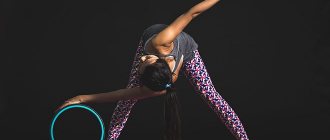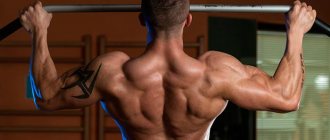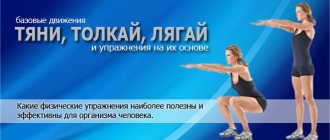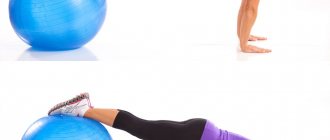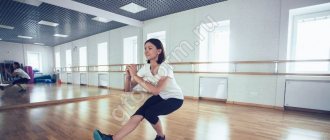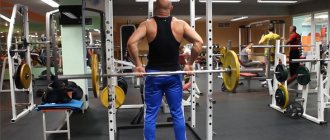Highlights in the formation
Exercises in formation are simultaneous manipulations of each participant and contain the following concepts:
- line - participants stand side by side on the same level;
- flank - different sides of the formation (after turning, the names of the flanks remain the same as at the beginning);
- front – the direction in which the athletes are facing;
- interval – the distance between each athlete;
- double-ranked formation - gymnasts stand in two ranks, and the distance between them is one step forward;
- closed-type formation - the interval between athletes is identical to the width of the palm;
- open-type system - the distance between people is no less than a step or the indicator specified by the coach;
- column - a formation characterized by the fact that all athletes look at the backs of each other's heads.
To successfully conduct a lesson, all athletes must clearly know each of the concepts presented, as well as understand the teacher’s commands. Otherwise, the lesson will be seriously complicated, and the order will be disrupted because of just one person.
Athletes are required to:
- have an idea of your location and be able to stand on it after receiving instructions;
- during the exercises, maintain the interval and distance from the other athlete marked by the coach;
- do not leave the ranks without obtaining appropriate permission;
- do not talk during the exercises;
- clearly implement the trainer’s commands and, while following this task, do not act as an obstacle to others.
https://youtu.be/zMiUNIZZWMQ
Pros and cons of this type of fitness for beginners
Useful characteristics:
- A set of exercises based on basic steps helps you quickly burn excess calories and reduce subcutaneous fat.
- Strengthens the heart muscle and improves blood circulation.
- Exercises on the stepper are useful for the muscles of the back, arms, buttocks and legs - they form beautiful posture and a slender silhouette.
- Improves motor coordination, developing dexterity and flexibility.
- It is possible to easily adjust the load level using tempo and various motor elements.
- Exercises on a stepper without weights or with dumbbells can be practiced not only in a fitness club, but also at home.
- Step aerobics can be used as a warm-up before strength training.
Negative points:
- Increased stress on the knees, which increases the risk of joint injury (with incorrect movement technique).
- For sports progress, you should exercise regularly without breaks (the basic result of losing weight, pumping muscles, etc. depends on how many fitness workouts you can practice per week).
- A large number of beginners find it difficult to adapt to training due to new movements, unfamiliar names and fast pace.
Techniques and movements in formation
Taking a position in the ranks is required after receiving the command “Stand!” As soon as this instruction is heard, you must immediately take your place in the ranks and level up as much as possible. There should be no tension in the body, the heels are connected, and the toes are turned forward. The legs are straightened at the knees, but they should also be relaxed as much as possible. The chest rises, the torso moves forward. The stomach is drawn in, the shoulders are turned. The hands are positioned so that the hands turn palms inward. The fingers are bent and touch the thigh. The head is held level, the face looks forward.
Hearing the command “Attention!” you need to stop taking a stance and freeze. After the order “At ease!” a free position is assumed, the knees are weakened, but it is strictly forbidden to start conversations.
Turns in place and in motion are carried out by receiving instructions. The concept of a half-turn means a 45-degree turn; this action is performed over the left shoulder. In other cases, you need to turn over your right shoulder.
Turns are carried out on two counts: on “one” you need to turn, while maintaining the correct position of the torso, the knees are straight, and all the weight is transferred to the leg located in front; At the count of “two,” the second foot is quickly placed.
All drill-type movements are performed while running or marching. The optimal speed of movement in steps is one hundred and twenty steps in 60 seconds (provided that the step length is about seventy centimeters). When running, the norm is up to one hundred and eighty steps.
This takes into account the fact that steps are divided into combat and marching. In the first situation, the command “Formation step - March!” is carried out, in the second situation - “Step - March”. At the initial command, the body moves forward a little, all the weight goes to the right leg, the position should be stable. After receiving a command requiring immediate execution, you should move with your left foot and in full step.
During the march, the toe is pulled forward and the leg is raised by 150-200 mm. Place your foot firmly and on a level foot. At the same time, work is done with the arms: they are directed forward and bent at the elbows, the hands are placed at the level of the belt buckle, back - to the point of failure in the shoulder area. The fingers are slightly bent. When following the instructions, keep your head and body straight and look forward. When performing a walking step, there is much more freedom in movement.
To start, the command “Run - March!” must be heard. If you run from a standstill, the step should be taken with your left foot. In order to switch from walking to running after receiving an order, you need to bend your elbows slightly and move them back. The command to be executed must be carried out in parallel with the installation of the left lower limb on the ground. Following the same instructions, a step is taken with the right foot, and the transition to running is made with the other foot.
What do lunges pump?
When performing lunges, two joints are primarily involved: the knee and hip. In this case, the following muscles come into play:
- buttocks;
- shins;
- hamstrings;
- quadriceps thighs;
- calf;
- synergists;
- soleus;
- abdominals;
- backs.
The main load falls on the muscles of the buttocks. However, it is worth noting that with a long step, the gluteal muscles are loaded to a greater extent, while short lunges – on the quadriceps of the thighs.
The advantage of lunges is that they work a large number of muscles while using light weights. Which, with the correct technique, reduces the likelihood of injury, but works well for the lower body and promotes harmonious development.
Features of moving in formation
In order to quickly fit into the gym during gymnastics classes, they use rearrangement, movement and disconnection.
Rebuilding is of the following types:
- From the line to three others. After making the calculation, the coach gives the command to move the group in three ranks. Having heard this instruction, the gymnasts who received the 2nd numbers in the calculation remain motionless, the athletes with the 1st number step back on the right foot, the left one is not added. After this, they move to the left and put their foot down; in the final position, they should look at the back of the head of the athletes with the second number. Group members who received number 3 step forward with their left foot, then similar actions are performed to the right and the second foot is placed. The final position of the athletes who received 3 numbers during the calculation is in front of the athletes with 2 numbers. To line up back, the coach gives the command to separate the group into one line. Gymnasts perform the same movements, only in reverse order.
- A ledge. After completing the initial calculation, the coach instructs certain numbers to carry out the number of steps specified by him. Athletes walk and then plant their feet.
- From a simple column to a column of three or four people. The coach gives the instruction “Group to the left in a column of 3 (or 4) - MARCH!” Having heard this command, the first three or four athletes turn in the indicated direction and move straight; the remaining athletes perform the marked movement without a new command. The leader notes the interval and size of the distance between the participants in the formation, which they must observe. After receiving instructions to reverse formation, the first three or four athletes go straight, changing into a column one at a time as they go. Other athletes perform a step on the spot, as a result of this command, they must look at the back of the head of other team members.
Movement also comes in several types:
- Along the perimeter of the hall. Having received the required command, the gymnasts move along the lines marking the boundary of the site, entering with the right shoulder, without implementing auxiliary instructions.
- Diagonally. The command “Diagonally - MARCH!” is performed only in the situation when the athletes approach the corner of the hall. Having received instructions from the coach, the gymnasts, behind the guide, move to another corner.
- By counterpropulsion. In this case, the entire column moves behind the guide in reverse (back to front).
- Snake. The movement consists of several counter-movements. The length of the snake directly depends on the first counter stroke.
Moving on to the opening, it is worth noting that this is a method of increasing the distance and interval of the formation. If the number of steps was not marked, then the opening is one step in any of the directions marked by the coach.
Everyone except the person from whom the release is made turns right or left and then advances so that the distance between athletes located on the sides, behind or in front is equal to the marked number of steps. After this, a turn is made to face the front. Having given the instruction, the coach performs a count of twos until each group member takes his starting position in the ranks.
There are several types of opening:
- Extension steps are used. It is carried out along the front after receiving the instruction: “Open from the center to the left (right) by 2 (or 3) steps with side steps.” Having followed the instructions, the coach counts to two until each member of the group takes his place.
- By order. For example: “Take a position three steps away from each other.”
- Along guides in columns. In such a situation, the coach sets a certain interval.
How to do aerobics correctly
- Whatever type of aerobics is chosen, the main condition for effective training is that it lasts at least 45 minutes, but not more than one hour.
- The music should be matched to a tempo of 130-135 beats per minute; you can find special tracks for aerobics or functional training.
- The workout begins with a warm-up, which consists of simple exercises and should last about 7-10 minutes; this is an important factor in preventing injuries.
- The main part - learning ligaments and combinations of movements - should last about 40 minutes, or 30 minutes - the main part and 10 minutes - strength exercises.
- At the end of the workout, a cool-down is performed, which lasts 7-10 minutes and includes a set of calming exercises and muscle stretching. Learn more about how to stretch after a workout →
- 3 workouts per week are enough; doing aerobics every day is contraindicated.
Clothes and shoes for aerobics
Aerobics refers to moving areas, so shoes should be comfortable and functional, namely sneakers for fitness or running, the sole should not slide on the floor and fix the ankle joint too much.
The clothing is absolutely free: it consists of elastic and tight materials that do not restrict movement, and natural ones - a loose and wide cut, in general, for every taste.
It is also important to note that special shorts, overalls and weight loss belts are contraindicated.
Marketers position such products as weight loss accelerators, but this is not the case. Dense warming and non-breathable materials provide the effect of a sauna and simply remove more fluid from the body, while fats are burned no faster. This is even more dangerous, since overheating during already intense movements increases the load on the heart.
Steps in classical aerobics
Basic basic steps in connecting and warming up aerobics.
Grape-wine
Aerobics lessons in video format
The connection of ligaments and basic movements are clearly shown in the video aerobics lesson for beginners:
httpv://www.youtube.com/watch?v=embed/d5bznQLUUuc
Aerobics lesson No. 2 in video format:
httpv://www.youtube.com/watch?v=embed/hSMegRQmVbM
Aerobics lesson No. 3 in video format:
httpv://www.youtube.com/watch?v=embed/_p2XH1tOXiQ
Directions
When performing drill exercises in gymnastics classes, there is a division of teams into two types:
- preliminary – force the athlete to gather himself and prepare for further actions;
- executive - require the athlete to immediately execute the command.
The executive commands include “Equal!”, “Attention!”. But if you want to attract the attention of students, the trainer can insert words such as “group”, “attention” in front.
The preliminary command is given as clearly and loudly as possible, even a little drawn out. This is necessary so that athletes immediately understand what is expected of them and prepare for the task. The executive-type command is given after a short pause, energetically and abruptly.
The volume and duration of the respite during these commands is directly related to the size of the formation: the greater the number of people in the formation, the longer the preliminary type command and the longer the pause between them.
The executive type of instructions helps to give a signal about the start of work; the pronunciation must coincide with the nature of the further actions. For example, in order for the formation to start running, the command must be carried out loudly and abruptly; if a slowdown is planned, then it must be loud and drawn out. Regardless of the type of command, the intonation is made as firm and commanding as possible. The coach must select the correct words, as well as vary the tone and strength of the movement.
The volume of the command must correspond to its need. It is strictly forbidden to give incredibly loud commands or very quiet ones, as this will disorient the students. In the process of giving the command, the coach must take the position of the main stance.
When executing the preliminary command, gymnasts stand at attention, so the coach should not abuse this instruction. If the command was nevertheless given, then it should be strictly followed.
In some situations, it is recommended to use orders instead of commands. If, when receiving a command, an athlete performs strictly defined actions, then having received an order, he may not follow the count and perform the specified action in other ways. For example, instead of telling students who are sitting on the floor to “Right!”, it would be preferable to ask them to “Turn to the right.”
When giving instructions to carry out a rebuild, you need to follow a number of actions:
- the name of the formation is pronounced;
- the direction in which the movement will be made is indicated;
- the execution method is indicated.
Rules for working with the step platform
In order for exercises on the steppe to benefit the body, you must follow the following rules for working with equipment:
- Your back should be straight while doing the exercises.
- Climbing onto the apparatus is carried out using the leg muscles.
- The entire foot is placed on the surface of the board; there should be no sagging of the heel or toes.
- You only need to exercise in comfortable non-slip shoes.
- You are allowed to stick your butt out when doing squats.
- You cannot jump or lower yourself to the floor with straight, tense legs.
- Movements should be fast, but not intermittent.
This type of sports activity is beneficial for the cardiovascular system, for improving coordination, balance, stability, endurance and elevating mood.
To practice step aerobics, you do not need to have special physical training, because every person can move up and down the steps. During training, walking on the “step” will alternate with jumping and squats. Even those who didn’t like these standards at school are happy to stomp and jump to the music. And losing 4 kg of excess weight from the body in a month will please any athlete.
Moreover, you don’t need to go to the gym specifically to practice the step; you can buy this equipment and practice sports on it at home. The projectile does not take up much space.
Training methodology
When familiarizing yourself with drill exercises in gymnastics, in most cases the demonstration method is used, all explanations are made in parts. As a result of the fact that drill exercises have a low level of complexity, during the training process the trainer most often combines explanations and demonstrations, after which he demands that the entire group perform the specified action simultaneously.
Complex variations of these exercises are studied in parts. In this situation, to carry out some action, you need to hear a separate command. For example, when changing from a line to two, the athletes who received the 2nd numbers according to the calculation first take a step back with their left foot, then a step to the right and at the end they just put their second foot down.
While studying the parts of the commands, the gymnast fully understands and remembers the actions performed, and the coach, before pronouncing a new command, may well correct already noticeable errors.
In order to learn the above exercises well, you need to practice performing them from the first lessons. Drill exercises cannot be studied theoretically, therefore, before demanding anything from athletes, the coach is obliged to show them the correct technique for performing a particular exercise, as well as show them how to execute various commands. There are also paired exercises, here the success of execution depends not only on one person, but also on his partner, so you also unlearn the features of working in a team, the ability to come to the rescue, and perhaps take on the entire load somewhere.
Through the use of drill exercises, gymnasts train endurance and discipline. These exercises have only recently been included in the modern training program for gymnasts, but have already gained great popularity because they teach athletes to strictly follow the rules and not give in to emotions, which is especially important when performing at various championships. Only composure and self-confidence will lead to victory and allow you to win numerous medals and certificates and respect in the sports field.
Losing weight with steppe
Working out on a step board is not only a fun, dynamic activity, but also an excellent fat-burning process. Steps and jumps familiar from infancy, it turns out, help get rid of excess “reserves” on the body. exercises on the step platform for weight loss are considered the most effective :
- Intense steps using weights or dumbbells.
- Jumping with landing in a half squat.
- Squats.
Regular gymnastics or strength training will not provide as much pleasure while burning extra calories as step aerobics. The first noticeable results will appear in a month.
https://youtu.be/KMwhb7XLjDg
